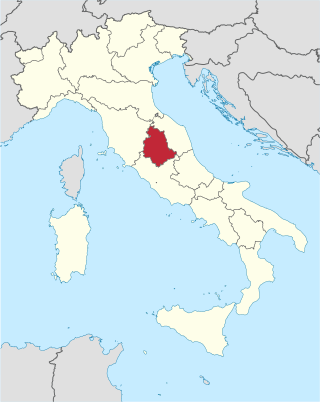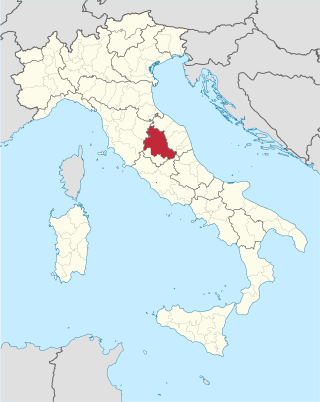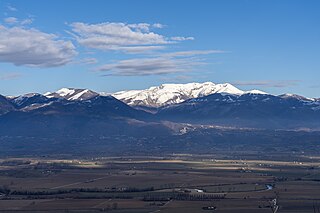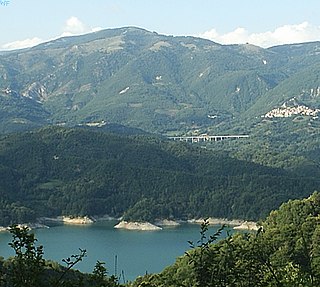
Umbria is a region of central Italy. It includes Lake Trasimeno and Marmore Falls, and is crossed by the Tiber. It is the only landlocked region on the Apennine Peninsula. The regional capital is Perugia.

Terni is a city in the southern portion of the region of Umbria, in Central Italy. It is near the border with Lazio. The city is the capital of the province of Terni, located in the plain of the River Nera. It is 104 kilometres northeast of Rome and 81 km south of the regional capital, Perugia.

The province of Terni is the smaller of the two provinces in the Umbria region of Italy, comprising one-third of both the area and population of the region. Its capital is the city of Terni. The province came into being in 1927, when it was carved out of the original unitary province of Umbria.

The province of Perugia is the larger of the two provinces in the Umbria region of Italy, comprising two-thirds of both the area and population of the region. Its capital is the city of Perugia. The province covered all of Umbria until 1927, when the province of Terni was carved out of its southern third. The province of Perugia has an area of 6,334 km2 covering two-thirds of Umbria, and a total population of about 660,000. There are 59 comuni in the province. The province has numerous tourist attractions, especially artistic and historical ones, and is home to the Lake Trasimeno, the largest lake of Central Italy. It is historically the ancestral origin of the Umbri, while later it was a Roman province and then part of the Papal States until the late 19th century.

The province of L'Aquila is the largest, most mountainous and least densely populated province of the Abruzzo region of Italy. It comprises about half the landmass of Abruzzo and occupies the western part of the region. It has borders with the provinces of Teramo to the north, Pescara and Chieti to the east, Isernia to the south and Frosinone, Rome and Rieti to the west. Its capital is the city of L'Aquila.

Greccio is an old hilltown and comune of the province of Rieti in the Italian region of Lazio, overhanging the Rieti Valley on a spur of the Monti Sabini, a sub-range of the Apennines, about 16 kilometres by road northwest of Rieti, the nearest large town.

The province of Rieti is a province in the Lazio region of Italy. Its capital is the city of Rieti. Established in 1927, it has an area of 2,750.52 square kilometres (1,061.98 sq mi) with a total population of 157,887 people as of 2017. There are 73 comuni in the province.

Rieti is a town and comune in Lazio, central Italy, with a population of 47,700. It is the administrative seat of the province of Rieti and see of the diocese of Rieti, as well as the modern capital of the Sabina region.

The Fucine Lake was a large endorheic karst lake between 650 and 680 m above sea level and surrounded by the Monte Sirente-Monte Velino mountain ranges to the north-northeast, Mount Salviano to the west, Vallelonga to the south, and the Valle del Giovenco to the east-southeast. Located in western Abruzzo in central Italy, the town of Avezzano lies to the northwest, Ortucchio to the southeast, and Trasacco to the southwest of the historic lake. Once the third largest lake in Italy after Lake Garda and Lake Maggiore, it was finally drained in 1878.
Rivodutri is a comune (municipality) in the Province of Rieti in the Italian region of Lazio, located about 70 kilometres (43 mi) northeast of Rome and about 13 kilometres (8 mi) north of Rieti.

The Cascata delle Marmore or Marmore Falls is a tiered, man-made waterfall in Italy, created by the Romans in 271 BC. At 165m tall, it is the largest man-made waterfall in the world. It is located 7.7 km from Terni, in the region of Umbria.

Monte Terminillo is a massif in the Monti Reatini, part of the Abruzzi Apennine range in central Italy. It is located some 20 km from Rieti and 100 km from Rome and has a highest altitude of 2,217 metres (7,274 ft).

The Velino is a river in central Italy, a tributary of the Nera. Its source is located on Monte Pozzoni's slopes (1,903 m) near Cittareale. Aftwards, it runs through a narrow valley next the Mount Terminillo, known as "Gole del Vento" and, near Antrodoco, receives the Peschiera Springs, which have a discharge of some 18 m³/s through an aqueduct.

Lake Fondi is a brackish lake about 90 km (56 mi) to the southeast of Rome in the Province of Latina, Lazio, Italy, in the region called Sud or "South" Pontino, the western end of which is the Piana di Fondi, "Plain of Fondi". The plain is a basin below the arc of the Monti Ausoni and the Monti Lepini. The lake forms naturally at the west end of the basin in a depression constantly filling with spring water exuding from the base of the mountains, which are a heavily cracked and faulted limestone karst absorbent of most rainfall. In addition to the flows from springs, a number of canals have been constructed from regions of the marsh below sea level to drain water from the marsh into the lake. Pumping stations are required to lift the water into the canals. Before the marsh was reclaimed the lake was part of it. Canals at either end of the lake connect it to the Tyrrhenian Sea.

Lago del Salto is a reservoir lake in the Province of Rieti, Lazio, Italy. At an elevation of 535 m, its surface area is 10 km².

Lago di Piediluco is a lake that straddles the border between the Province of Terni, Umbria, Italy and the Province of Rieti, Lazio. At an elevation of 375 m (1,230 ft), its surface area is 1.58 km2 (0.61 sq mi). The lake is formed by the inflow of water from three sources: the Rio Fuscello, the Velino river and the Nera river. The flow from the Rio Fuscello is naturally occurring, while the flows from the Nera and Velino rivers are each influenced in some part due to man-made means. A partial diversion of the Nera in the Nera river valley (Valnerina) conducts the flow via a lengthy aqueduct and canal system built in the 1920s during the fascist regime of Benito Mussolini, entering the lake at the north-western end of the village of Piediluco, near the entrance to the town from the "Via Ternana" SS79 motorway. A canal approximately 400 metres (1,300 ft) long was built, also in the 1920s, to divert the Velino river from its existing natural course into the lake. The purpose of this work was to improve hydroelectric power production.

The ancient Roman villa of Quintus Axius was a large rural villa rustica in the locality of Grotte di San Nicola, Colli sul Velino, Italy.

Mount Giano is a mountain in the central Abruzzo Apennines, 1,820 m above sea level. Located on the border between Lazio and Abruzzo, along the Apennine watershed, it belongs to the Cicolano Mountains subgroup.





















